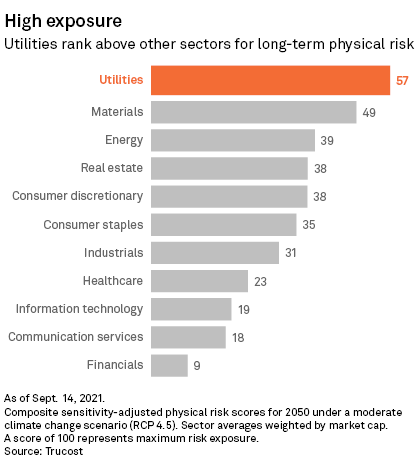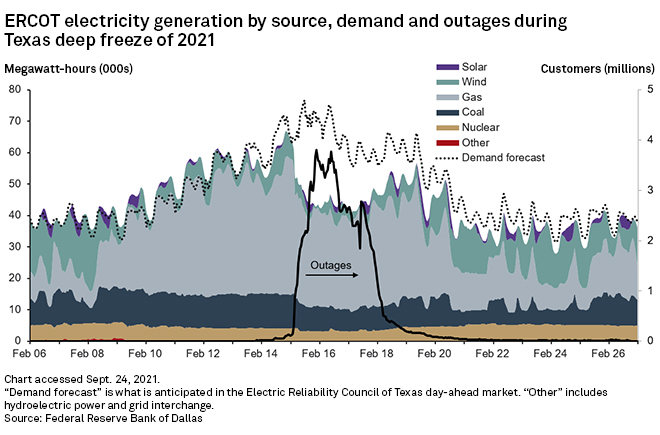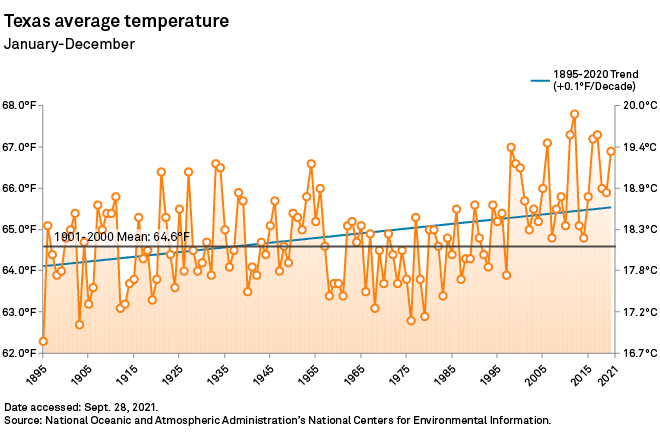S&P Global Offerings
Featured Topics
Featured Products
Events
S&P Global Offerings
Featured Topics
Featured Products
Events
Subscribe to start every business day with our analyses of the most pressing developments affecting markets today, alongside a curated selection of our latest and most important insights on the global economy.
SUBSCRIBE TO THE NEWSLETTERClimate change is pushing power, gas and water companies to the frontlines of an intensifying battle against natural disasters that is set to increasingly hit the profits of businesses around the world.
Utilities face the highest combined physical risk from climate hazards like water stress, storms and wildfires among different industries, according to an analysis of data from Trucost. The analysis, which ranks threats to the physical operations of around 15,000 public companies, shows utilities' vulnerability to physical climate risks generally tops other capital-intensive sectors like industrial manufacturing, oil and gas and real estate.
Extreme weather events are likely to become even more frequent and intense as a result of rising temperatures, and experts argue that many businesses are not fully prepared to cope with the physical and financial impacts.
"Physical climate risk really is everywhere," said Christopher Schwalm, risk program director and senior scientist at the Woodwell Climate Research Center, a U.S.-based think tank that works with companies on pinpointing their climate risk. "That hasn't quite achieved the level of resonance it ought to have in the broader corporate world."
Among the seven different physical risk factors assessed by Trucost, water stress ranks by far the highest for utilities. Aside from water utilities and hydropower producers that will see their primary resource stretched by increasing droughts, thermal power generators like coal and nuclear plants also rely on vast amounts of water to cool their systems. 
Keeping The Lights On: U.S. Utilities’ Exposure To Physical Climate Risks
The risks of acute, extreme weather events for U.S. utilities are rising. Five of the country's worst natural disasters have all occurred since 2005, totaling $523 billion in inflation-adjusted damage.
Read the Full ReportEntergy's Hurricane Outages Shine Spotlight on U.S. Grid Challenges
With most of New Orleans suffering through a third day without power, Entergy Corp. faces questions about whether it was sufficiently prepared for another monster storm pummeling the city.
Read the Full ArticleMich. Regulators Launch Inquiry into Electric Utility Storm Response
The Michigan Public Service Commission directed DTE Electric Co., Consumers Energy Co. and other electric utilities to file a report on their response and distribution system performance during the Aug. 10-12 storms that left nearly 1 million residents and businesses without power.
Read the Full ArticleAbout 1.2 Million Customers Without Power in Hurricane Ida's 'Catastrophic' Wake
The extremely powerful Hurricane Ida cut off almost 1.2 million customers from electric service as of about 1 pm CT Aug. 30, and according to Entergy, the largest utility serving the area, "Those in the hardest-hit areas could experience power outages for weeks."
Read the Full ArticleThe California Independent System Operator remains under a flex alert and restricted maintenance operations notice because of expected high loads and temperatures across the footprint with gas supply concerns in Southern California.
The alert and notice started Sept. 8 with the flex alert extended until 9 pm Sept. 9 and the restricted maintenance operations notice extended until 9 pm Sept. 10.
Peakload reached 43.591 GW Sept. 8, the highest in a year, according to CAISO data.
"The ISO is predicting an increase in electricity demand, primarily from air conditioning use," according to a Sept. 8 ISO statement. "The increase can stretch electricity supplies thin and cause strain on our power grid, especially in the late afternoon and evening, when solar production goes offline and wind generation is uncertain, however, temperatures and electricity demand remain high."
There is more natural gas being used than scheduled. SoCal Gas is showing estimated receipts of about 2.4 Bcf/d, with sendout above 2.8 Bcf/d, so storage draw is more than 400 MMcf/d, and it will probably need to pull gas from Aliso Canyon, which usually implies very high prices, said Morris Greenberg, senior manager of North American Power for S&P Global Platts Analytics. 
ERCOT Generation and Transmission Winterization Rules Proposed for Publication
Generation and transmission entities in the Electric Reliability Council of Texas would have to complete by Dec. 1 "all actions necessary to prevent a reoccurrence of any cold weather critical component failure" that occurred in the winter of 2020-21 under weatherization rules proposed for publication and filed by Texas regulatory staff Aug. 25.
Read the Full ArticleNew York City Calls on Households, Businesses to Cut Power Use Amid Heat Wave
New York City issued an emergency alert late June 30, urging electricity users to dial back consumption to avoid power failures as a heat wave, with temperatures above 95 degrees Fahrenheit, stressed the power grid.
Read the Full ArticleERCOT Requires More Market-Design Reform to Promote Grid Resiliency: CPS CEO
For the Electric Reliability Council of Texas to avoid another energy emergency, such as what occurred during the deadly mid-February winter storm, it has "a whole lot more to do with market design," the head of San Antonio's CPS Energy said July 30.
Read the Full ArticleAs Heat Wave Looms, ERCOT and Texas Regulators Emphasize Grid Readiness
Texas regulators and the Electric Reliability Council of Texas sought on July 22 to reassure Texas power consumers that they are doing what is necessary to ensure the power system remains reliable for the rest of the summer, as August is typically the hottest period of the Texas summer.
Read the Full ArticleExtreme Weather Challenges California Grid as Goal Remains Decarbonization
As extreme summer weather tests the California power grid, opportunities for reliability alongside deep decarbonization and achieving 100% renewable power remain, state regulators said June 16.
Read the Full Article
U.K. Prime Minister Boris Johnson has said 100% of the country's electricity could come from renewables by 2035.
The goal — outlined during the Conservative Party conference on Oct. 4 — builds on the government's target to cut CO2 emissions by 78% by 2035 compared with 1990 levels and comes amid a period of stress in the U.K. energy system caused by rising international gas prices.
S&P Global Platts reporters assess the scale and impact of decarbonizing U.K. power by 2035:
Energy flows
The contribution made by renewables to U.K. power generation has more than doubled since 2014.
Renewables (mainly wind, solar, biomass, hydro) accounted for 43% of the U.K.'s 312 TWh of domestic power generation in 2020.
S&P Global Platts Analytics forecasts renewables plus nuclear will account for 56% of U.K. power demand in 2026, with wind output set to double from current levels to 131 TWh/year.
The U.K.'s single-largest source of power generation is natural gas, with demand rising in periods of low wind -- as in September, when power prices averaged over GBP177/MWh ($241/MWh) as a result.
Gas-fired generation is forecast to account for around 33% of demand in 2026, up from 31% in 2022 under Platts Analytics' latest five-year-forecast published in August.
U.K. gas-for-power use amounted to 17 Bcm in 2020. Norway supplied a third of total U.K. gas supply in 2020 and more than half of total imports. Qatar was the dominant LNG supplier to the U.K. in 2020, representing 48% of total LNG deliveries, followed by the U.S. (27%) and Russia (12%).
All the U.K.'s existing nuclear reactors will have closed by 2028 bar Sizewell B, with only the in-construction Hinkley Point C set to enter operation in the meantime.
Nuclear accounted for 16% of domestic U.K. generation in 2020, down from 21% in 2016.
A funding mechanism for EDF's two-unit Sizewell C project has yet to be confirmed, leaving its 3.2 GW Hinkley Point C as the U.K.'s only nuclear project in construction.
Infrastructure
U.K. offshore wind costs have dropped dramatically in recent years, enabling the government to ramp up target capacities, extend concessions to far offshore sites, and contemplate floating wind technologies.
The U.K. targets 40 GW of offshore wind capacity by 2030, up from 11 GW today. In December, a fourth contract for differences auction is forecast to award around 12 GW of new capacity.
The U.K. also has around 12 GW of onshore wind and 14 GW of solar. Both are re-admitted to the next CFD auction, but must fight over modest funding.
De-carbonized thermal balancing plant, storage and demand response are seen as essential components of a renewable energy power system.
Biomass generation, defined as carbon neutral, averaged 2.3 GW in the year to end-September, the vast majority of this at Drax’s Selby site in North Yorkshire.
Around 3.6 TWh/year of biogas produced from anaerobic digestion is injected into the national gas grid in the U.K. This could top 50 TWh/year by the early 2030s, equal to 6% of the UK’s current gas consumption.
The U.K. aims for 5 GW of low- or zero-carbon hydrogen production by 2030, linked in part to a goal to capture 10 million mt/year of CO2 by then and store it under the North Sea. 
Los Angeles Directs Utility to Aim for Net-Zero Emissions by 2035
A Los Angeles City Council motion declaring that all of the city's electricity come from zero-carbon sources by 2035 will prompt the city-owned utility, the Los Angeles Department of Water and Power, to drastically remake its power generation portfolio.
Read the Full ArticleCal-ISO Wind, Solar Curtailments in August Higher Year on Year
California Independent System Operator wind and solar generation curtailments climbed 58.3% year on year in August as installed renewable capacity has increased 1.762 GW from year ago levels while demand decreased year on year.
Read the Full ArticleThe Path To Net-Zero Emissions: Credit Perspectives On What This Means For Some U.S. Regulated Electric Utilities
There are many components on the path to net-zero that have to work well in order for some utilities to achieve their goals, beginning with articulating a clear resource strategy that is beneficial for ratepayers.
Read the Full ReportCalifornia Unlikely to See Power Market Changes Despite Close Governor Recall Election: Experts
The outcome of the California governor recall election is unlikely to have immediate impacts on wholesale power markets or existing laws such as the one concerning state's goal of 100% clean energy by 2045, but the leading opponent would likely change the heads of the state's various utility commissions, industry experts say.
READ THE FULL ARTICLEBattery Storage Capacity Rapidly Rising Across California, Thermal Remains Strong
Battery storage is taking off in California with nearly 1.2 GW of capacity added in the last year and expected to double before the end of the year, despite COVID-19-related supply chain delays that have helped boost natural gas demand, along with lower hydro and imported generation.
READ THE FULL ARTICLEWind Energy Sector Accounted for 42% of New Capacity in 2020, a Record High
Record growth in the wind energy sector is helping the U.S. make progress toward President Joe Biden's 2035 clean electricity goal even as the country remains "well behind" China, Denmark, Germany and other wind leaders in the percentage of power it gets from the energy source, the U.S. Energy Department said.
Read the Full ArticleFour aeroderivative natural gas turbine generators are now in operation in California following a July emergency proclamation to increase summer capacity, regulatory order for emergency generators and a tariff waiver to increase interconnection capacity.
The four units, totaling 120 MW and located next to existing power plants, were installed at two sites in Northern California following an emergency proclamation by Governor Gavin Newsom that directed the Department of Water Resources to work with the California Energy Commission to develop additional energy capacity to safeguard the state's grid from the impacts of climate-induced drought, wildfires and extreme heat waves. California faces an energy supply shortfall of up to 3,500 MW in 2021 and roughly 5,000 MW in 2022.
"DWR's expertise as the fourth largest power producer in California allowed us to work quickly with the CEC, the California Independent System Operator and our regional partners in Yuba City and Roseville to bring these units online," DWR Deputy Director for the State Water Project Ted Craddock said in a Sept. 29 statement. "DWR is proud to play a role in safeguarding the state's energy grid and doing everything possible to avoid power shortages and outages as a result of climate-induced conditions."
The periods of stress have been in early evening hours after solar generation ramps down yet power demand remains high, CAISO said in its 2021 Summer Loads and Resources Assessment released May 12. Low hydro conditions increase grid vulnerability, particularly in late summer.
The Energy Transition And What It Means For European Power Prices And Producers: September 2021 Update
S&P Global Ratings has raised its base-case assumptions for power prices by up to 10% in five of Europe's main markets over 2021-2023 from its January 2021 assumptions.
Read the Full ReportChesapeake Utilities, a Small Utility Operator, has Big Renewable Gas Plans
When asked how big he wants his company to be in the renewable gas market, Chesapeake Utilities Corp. President and CEO Jeff Householder offered an observation: "You're the 95th person that's asked me that question in the last two days."
Read the Full ArticleSRP Proposes to Expand Coolidge Gas-Fired Power Capacity as Bridge to More Solar
Salt River Project wants to expand capacity at its quick-start, natural gas-fired Coolidge Generating Station plant to ensure a reliable backup for the Arizona utility's planned increase of solar-generated power, SRP said Aug. 25.
Read the Full ArticleSoCal Gas City-Gate's Winter Strip Hits New High as California Increases Reliance on Gas
SoCal Gas city-gate's winter strip climbed to a fresh year-to-date high in the week started Aug. 22 as an increasingly weak hydropower outlook deepens California's expected reliance on gas-fired generation even as pipeline constraints limit gas inflows into the region.
Read the Full ArticleSeven months after a deadly Arctic blast nearly took down Texas' power grid, state and federal regulators are still trying to create rules to prevent another such disaster as winter approaches.
Federal officials said recently it will take years to update national standards for power plants to protect against severe weather. Texas state regulators have not finalized their beefed-up weatherization rules, mandated by the Legislature in the spring, leaving plant owners in limbo. Grid officials have said a study that will help regulators create the new rules will not be released until the end of January.
New standards for weatherizing natural gas facilities such as pipelines and wellheads, many of which failed to deliver fuel to power plants during the February blast, will not be finalized until two years after the storm triggered blackouts that led to hundreds of deaths in Texas. The timeline angered state lawmakers, who on Sept. 28 grilled Wei Wang, executive director of the Texas Railroad Commission, which is responsible for adopting the rules.
Lawmakers accused the Railroad Commission of creating a loophole for natural gas facility owners, who under a current proposal can submit a $150 application to opt out of being designated as critical infrastructure during weather emergencies.
"I recognize the urgency" of preparing the natural gas supply chain for the upcoming winter, Wang said at the hearing of the Senate Committee on Business and Commerce.
"I don't think you do!" replied Republican Sen. Donna Campbell, who threatened to fold the Railroad Commission into the Texas Public Utility Commission if the former does not hold the gas industry accountable.
PUC Chairman Peter Lake insisted the agency is moving forward with "substantial and rapid rulemaking."
"The bottom line is, we will be going into this winter with a more resilient grid than we had last winter," Lake told lawmakers. 
Lone Star deadline looms
Lake said minimum requirements called phase one standards will be in place in November.
"If you're a generator and you're [tasked with] paying all this money for upgrades, and you don't know what all those upgrades will be ... that's kind of hard to implement," Caitlin Smith, an energy policy adviser who used to work for the Electric Reliability Council of Texas Inc.'s independent market monitor, said in an interview.
The PUC is reviewing public comments on the phase one rule proposal. The rules, if approved, would require power plant owners to fix "known, acute issues" that arose last winter. The PUC is also working on a rule that would raise the maximum fine for weatherization violations to $1 million per day. 
Lawmaker Works Toward Senate Compromise in Push for U.S. Clean Electricity Plan
U.S. Sen. Tina Smith, D-Minn., is leading efforts in the Senate to add a national clean electricity performance program to the budget reconciliation package Democrats are working to advance through Congress.
Read the Full ArticleQ2'21 U.S. Power Forecast
Based on S&P Global Market Intelligence Q2 Power Forecast, CAISO, ERCOT and PJM are projected to have surplus reserve margins in varying degrees between 2021 to 2030.
Read the Full ArticleTwo Transmission Projects for 2.6 GW of Clean Power into New York City Selected
New York Governor Kathy Hochul Sept. 20 said two large transmission projects had been selected to transport wind, solar and hydropower from northern New York and Canada into New York City to cut emissions and help the state reach 70% renewable electricity by 2030.
Read the Full ArticleNYISO's Distributed Energy Compliance Plan Draws Fire at FERC
The New York ISO's attempt to integrate aggregations of distributed energy resources into its wholesale power markets has exposed a range of thorny issues surrounding a landmark Federal Energy Regulatory Commission rule.
Read the Full ArticleCryptocurrency Offers Opportunities, Challenges for Power Market Participants
Power demand from cryptocurrency mining data operations offers opportunities and challenges around decarbonization of the U.S. economy, panelists said Sept. 15 at the fall conference of the Independent Power Producers of New York.
Read the Full ReportDetails Emerge on House Clean Electricity Performance Program
The House Energy and Commerce Committee is considering a proposal that would establish a new U.S. Department of Energy program to provide grants for power companies that increase their percentage of clean energy by certain margins each year and impose fees on those that do not.
Read the Full ArticleCritics: PJM's Minimum Offer Price Rule Overhaul Will 'Crater' Capacity Market
The PJM Interconnection is facing fierce pushback to its proposed replacement for a highly contentious minimum offer price rule, or MOPR, used to blunt the effect of member states' clean energy policies in the grid operator's multibillion-dollar capacity market.
Read the Full ArticleBerkshire Hathaway Gas and Power Unit Urges U.S. Incentives to Support Clean Energy
Warren Buffett's Berkshire Hathaway, a major investor in US energy infrastructure and operator of the Cove Point LNG export terminal in Maryland, is putting its weight behind an industry push for passage of new legislation that would provide additional tax incentives for clean energy projects.
Read the Full Article
China will need to fundamentally revamp its power generation and distribution system by 2060, as part of its roadmap to decarbonize the power sector and accommodate a fuel mix that largely replaces fossil fuels with cleaner energy sources, according to experts at a recent conference in Nanjing. 
U.K. Looks to Promote Electrification Via Tax Switch from Power to Gas Bills: Report
The UK government is considering moving environmental taxes in residential electricity bills to residential gas bills to encourage electrification, the Financial Times reported Sept. 30.
Environmental and social obligation taxes make up around a quarter of the average residential electricity bill, according to energy regulator Ofgem.
EC Approves Belgium's Electricity Capacity Market Design
The European Commission has approved Belgium's electricity market capacity mechanism under state aid rules, it said in a statement Aug. 27.
Approval comes after months of EC scrutiny and offers relief to the Belgian government, which plans a first four year ahead capacity auction this October to compensate for the phase-out of nearly 6 GW of existing nuclear capacity by 2025.